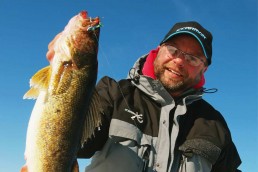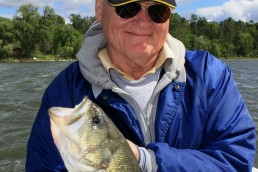Jigging Lessons from Motown’s ‘Eyes
SHARE THIS POST
March is a frustrating month for avid walleye anglers, especially as the days wane. While the first half can have some ice safe enough to fish upon, the latter part will see deteriorating conditions. Also, there’s the closure in the fishing season throughout many of the states in the Midwest and Canada to allow procreation to take place without harassment for this most sought-after species.
But there’s one place where the bite only gets better as March slowly turns into April, and that’s on the Detroit River. Here, within the flow that connects Lake St. Clair and Lake Erie, the season for targeting walleyes is open the entire year. The Michigan DNR estimates nearly 9 million of this species swim into this fast-flowing waterway to go through the rituals of spawn. But fishing does not come easy here. The current is quick and the wind can blow hard from most any direction and push you off course. Overall, it’s boat control what separates the anglers who land a limit from those who come back to the dock empty-handed. Luckily, vertical jigging can work here. But there are details that make a big difference in how many fish are landed. These tips and techniques can help you catch fish in rivers year ‘round, no matter where you’re fishing.
River basics
River fishing is unique in its own right. Unlike natural lakes, where 90 percent of fish only hold in 10 percent of the water, fish in rivers can be spread out throughout the entire system. It all depends on the flow. Is the water rising due to runoff from rain or snow or has a draught got levels falling? Is it muddy or clear? Is it cold or warm? There’s so much riding on the water’s environment of the moment.
Overall, in the Detroit River waters are flowing fast and slightly elevated due to runoff from melting ice from Lake Huron and Lake St. Clair. Ultra-muddy water conditions can be the death of a good bite, while lightly stained water is more desirable. If the water’s too dirty downstream, though, I’ll motor upstream to find cleaner conditions.
In most river systems, walleyes will head right to the bank as the water rises, and I’m sure fish do so in the Detroit River. Pitching jigs to the bank or even up onto the flooded grassy plains is a great ploy in most waterways, but the riverbanks here are “industrial” in nature, thus tossing a jig in the shallows means snags and lost tackle. Your best bet for finding key areas here is to use an SD card filled with Navionics mapping to find holes and runs in nearshore areas. With this card in the reader of my Lowrance HDS-12 Gen3 sonar/chartplotter combo, I can then see where every hole, hump and bump lies underwater and can find more places to catch fish, even in waterways I thought I knew.
Ready, aim, drop
Once I’ve found a place to fish, I motor my boat well above the run. And as I’m pointed upstream I deploy my bow-mounted electric trolling motor and get its prop spinning. An electric trolling motor in the bow is the most important piece of equipment when it comes to boat control. My foot is continuously on the control pedal, endlessly turning left, right, goosing the power up or turning it down all so I can keep the boat moving downstream at the exact same speed as the current. And believe it or not, controlling my boat is why I also spool up very bright Berkley FireLine, such as Flame Green or Crystal, on my Abu Garcia reels. What I am trying to achieve is a perfect vertical presentation.
Are you enjoying this post?
You can be among the first to get the latest info on where to go, what to use and how to use it!
The rods I use for vertical jigging here needs to be slightly heavier in power than what I would use in a lake, and have a fast action. This allows me to feel the moment my jig taps the bottom so I can then lift it up and out of a snag-prone area, allowing me to pull huge walleyes up. Fenwick’s 6-foot 6-inch, medium-action Elite Teck Walleye spinning rod works for me.
I prefer 8- to 10-pound-test for line, and I tie Superline directly to a jig using a Palomar knot. I also prefer jigs that are heavy, rather than going with my usual, which the lightest winds and waves will let me get away with.
Nip and fall
It was in the early 2000s that live minnows were the only bait folks were using in the Detroit River (most anywhere, for that matter). But then came soft baits like Berkley’s PowerBait and GULP. Jigging baits like these helps lower the jig to the bottom. The moment you feel the floor, just lift the lure 1 foot, then repeat. Walleyes bite extremely light, so hits may feel nothing more than an ultra-light “tick” or just something different from all the other ups and downs you’ve made with bait.
Comfort-keepers
Some things anglers might skimp on when buying gear can be some of the most important items in your boat. Take rainwear, for example: If there’s one thing reliable about the weather this time of year is its unreliability. Totally waterproof and warm jackets and bibs are necessary on the Detroit River and others, so the right outer clothing like the Typhoon by STORMR, are essential for staying comfortable, which helps one concentrate more on catching fish. On the other hand, the sun could pop out from the clouds and be quite intense, even in March. To ward off the first sunburn of the season, use a high-quality sunscreen and wear quality sunglasses like ones made by Costa Del Mar.
Motown teachings
The Detroit River is a unique fishery, but the lessons you learn here will be priceless in any river. By far, boat control is the crucial link between landing a limit and going back to these Michigan shores empty-handed. Use a bow-mounted electric trolling motor to your advantage. And, use heavier jigs when you’re vertical jigging, but don’t overlook soft baits or live baits.
MWO
SHARE THIS POST
Did you enjoy this post?
You can be among the first to get the latest info on where to go, what to use and how to use it!
Mark Martin
Mark Martin is a professional walleye tournament angler and instructor with the Ice Fishing School/Vacation series. For more information, check out his website at markmartins.net or fishingvacationschool.com.



